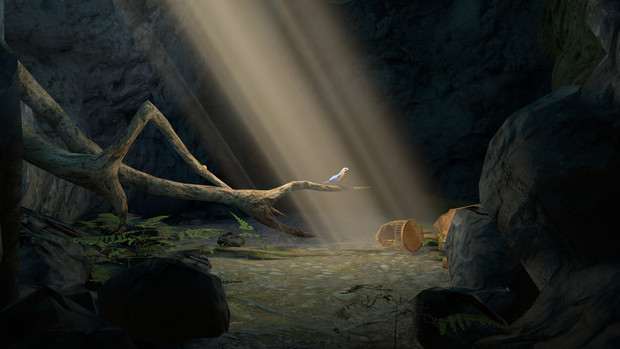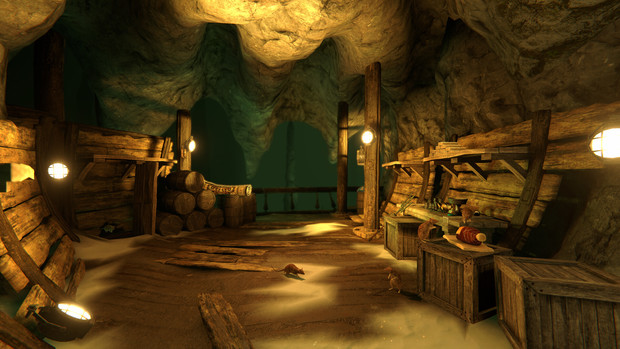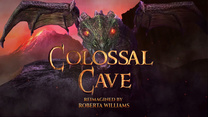Colossal Cave VR review

- 0 Comments
Exploration is the real treasure of the new, improved groundbreaking classic in immersive VR
In my younger days of adventure game fandom, I would often engage in a standard debate over the core appeal of the genre: story or puzzles? Of course, this ridiculous argument is a wildly oversimplified way to frame the question, but for those like me who loved participating in such useless debates, it seemed to neatly delineate two core groups of adventure fans: those who wanted to get lost in a story and interact with characters with the hope that intellectual challenge would not make itself the focus, and those who find the joy of interactive entertainment to be the challenge of solving difficult puzzles, without the window dressing of unnecessary dialogue and melodrama to cloud brain stimulation. Now, obviously any reasonable person would agree that the answer is somewhere in the middle and that any truly great adventure must balance both of these elements, but lost in this story vs. puzzles debate is an often undiscussed and less fully realized appeal of adventure games: the joy of immersive exploration.
And of course there’s a pretty good reason that exploration hasn’t often been cited as the primary appeal of adventure games: in the much more limited technology of the Golden Age of adventure gaming, it was very difficult to create environments that would be considered truly immersive. The backgrounds were often pretty, the continually iterative animation frequently impressive, but how could any of it truly feel like an actual exploration when viewed through a 13-inch monitor? Even as the technology evolved to present three full dimensions, you were still looking at those dimensions on a flat screen in front of you, and that’s hardly a way to feel like you’re truly experiencing a real environment. So, bound by that technology, developers relied on what they could accomplish within those limitations, which were great stories and intellectual challenges.
But now, 40 years removed from literally creating our beloved genre of graphic adventure games and founding the company that would bear its standard, Sierra luminaries Ken and Roberta Williams have stunningly re-emerged from retirement, ready to return to making games. The first project of their new endeavor Cygnus Entertainment, a modern re-imagining of the 1976 text adventure Colossal Cave, is an adventure whose primary appeal is the immersion of true exploration. One year after the game’s initial release on a variety of platforms, with an impressive number of updates to improve the experience ever since, I was provided the chance to play the new 2.0 version on a Meta Quest 2 headset. And having spent many hours exploring the caves, I can confidently say there is no better way to experience Colossal Cave than playing the game in VR.

You don’t need the entire history of either Colossal Cave Adventure or Ken and Roberta Williams to be recounted here, but I think to understand the enjoyment of playing this game in VR, it is important to understand who Will Crowther, the original designer of the first ever text adventure, was. Besides being a brilliant programmer, he was also an avid spelunker in Mammoth Cave National Park within his home state of Kentucky. After a divorce that left him “pulled apart in various ways” and unable to actively participate in caving, he decided to recreate his enthusiasm for exploring the underground through his professional knowledge of the Fortran programming language. Ultimately, all Will Crowther was trying to do was take the joy he found in cave exploration and translate that into a game that his kids would find a fun experience.
At the time they had to find that fun almost solely through their imaginations, since that 1976 game was purely a text adventure. However, with a VR headset players are no longer responsible for imagining the details, and the (virtual) reality of the titular cave is a beautiful one where every room, every rocky outcropping, every natural staircase and every dark crawl space feels unique and artfully designed. While there’s obviously an abundance of darker colors in an underground setting, the game is surprisingly quite colorful, with scenes filled with bright mushrooms, reflective water, and numerous other environmental touches that are truly delightful to just stop, walk up to and examine as if you’re really there. Each stalactite, every branch, the shadowy grooves of every rock wall—it’s impressive how easy it is to get lost in the details in a way that I didn’t think would be possible just looking at screenshots of the game’s PC version on my phone. That’s really the joy of exploration: less than wanting to “play this game” per se, I found myself frequently lost in the fun of simply being in my environment, walking up to something interesting and studying it, with no regard for my current objective. Playing in VR provides the unmatched sensory treat of being up close and personal with every inch of the caves.
The controls are designed to provide maximum flexibility, with three different overall navigation options: a normal full-turn mode using the VR thumbsticks, which is immersive but also likely to cause disorientation; a mode that uses the triggers to move forward and backwards (noted as Roberta’s preferred method); and, if even that is too much free-form movement, there’s a recently added teleport mode to really cut back on the motion. Colossal Cave VR also allows for you to increase or decrease the speed of movement on a very wide spectrum, as well as turn on and off snap-turn rotation and press the left stick in to toggle running.

This level of customization is essential, because as I quickly found after bragging to my wife that I never struggle with motion sickness, everyone in fact has a threshold to get a little queasy, and once you find yours you’ll be able to set your navigation anywhere from dizzyingly fast real-time running turns (no thanks) to snap-turn slow walking, which is wisely how the game starts you off. Recent updates to this version have even added a “vignette” feature that focuses your view into a tight circle when you’re walking forward—not for any type of magical dramatic addition, but simply to help with the very real issue of VR motion sickness. No need to clear significant floor space either; you play in stationary mode and can choose whether you sit or stand, which may also assist with mitigating your potential vertigo. Considering how the game’s original release had significantly more limited navigation, the work that has gone into ensuring that every player can have an accessible experience and counter the most significant VR drawback is most welcome.
The ease of navigation tends to feed nicely into very natural interaction as well. On the Quest, as you move with your left thumbstick, you raise your right hand to activate the “cursor.” The right-side lower trigger cycles the active icon between look, interact, and current inventory item icons (in true old-school Sierra SCI fashion) and the right hand itself moves the cursor, with the second trigger activating. It may sound like a lot, and it will be for VR newbies, but there aren’t many moments where interaction becomes urgent, and I certainly never felt like it was clumsy or unnatural, which was a frequent complaint of the game’s early VR reviews. The entire experience of navigating and interacting with the world just feels very precise and polished now, and that makes exploration that much more freely enjoyable.
Though I won’t re-review the well-documented aspects of playing Colossal Cave that leave it feeling unapologetically old school in exacting detail, you’ll need to understand that the game part of the experience will find you fighting against some conventions that certainly can feel as stale as their faithfulness to a 1976 game would imply. The game boasts a 350-point scoring system that offers points for identifying and then securing the 15 treasures hidden in the cave by returning them to the well house outside. Returning treasure sounds pretty simple, but there’s also the matter of a very limited inventory that allows you to carry only seven items at a time—one of which will be a weapon that you need to keep to fend off attacks, and another will permanently be a necessary lantern. There’s a hint system (portrayed as a glow in the onscreen environment that the narrator prompts you to touch before it disappears), which doesn’t show up as often as it feels like it could, and the first time it did gave me an actual incorrect answer, telling me only that I should come back and deal with a particular bird at a later time when I actually already had the necessary item in my inventory—and that incorrect hint cost me 3 points to obtain.

You’re also going to die, whether from an accidental step off of a ledge (I can’t say that my falls ever felt cheap or poorly designed; I simply took a knowing risk of how far I could step and went too far or moved too fast) or a violent encounter with a knife-throwing dwarf, fire-breathing dragon, or other game-ending creature, never mind the potential of being sealed into the cave permanently during a brutal endgame sequence—what, did you really expect Roberta Williams to suddenly decide that torturous in-game deaths are passé? The question once you die will be, did you take advantage of the opportunity to save your game at any point? If not, don’t expect to be rescued by one of these silly modern autosave systems; you can only be revived and sent back to the game’s starting point outside the cave, and you’ll lose points to do so. Save early, save often, and perhaps depending on your age, wonder how these old geezers ever existed with games that don’t automatically restore us to the point ten seconds before we died without fail.
Though the story of Colossal Cave is about as non-existent as it could be—you are simply a devoid-of-personality explorer who happens to find himself near a Mammoth-style cave system rumored to contain all manner of valuable rewards—I definitely don’t want to imply that Colossal Cave doesn’t scratch the puzzle itch at all. There are plentiful inventory puzzles, most of which are reasonably logical and some of which involve resisting the antagonists looking to end your adventure; the real challenges here will be remembering where in the cave you dropped the item you currently need in service to your limited inventory. There are also a handful of magic spells triggered by learned words (the learning of which can be dependent on randomness, as are many moments in the game), most of which teleport you between rooms, which becomes a necessity at times; a very old-school maze with an exhausting array of possible exits from each room; and of course, the ever-present ticking clock of your lantern, which has light enough for only a certain number of “moves” before it expires and leaves you in the dark, with certain death around the corner. Save early, save often.
The sum effect of these factors, quite honestly, is to make it unlikely that many players will “beat” this game, and if you do you’ll almost certainly decide along the way that you could not possibly care less about getting a perfect score—especially not from a point system that actually penalizes you five points for simply reading the game’s initial instructions upon starting. The difficulty, inventory management, lack of linearity and occasional random aspects would test the patience of any generation, but most certainly the current one that isn’t used to such things and yet is most likely to own a VR headset. The automapping, a feature I’m certain was added with much grumbling by such a traditionalist designer, at least allows the player to feel anchored during their exploration, and the maps themselves are visually appealing and stylish, avoiding the boxy archaic look of the graph paper that 80s kids like me used to map out dungeons when that was the only option. Of course, these maps (which thankfully have icons that track the location of treasures after you identify them, even if your inventory doesn’t presently allow you to carry them) are most often only visual indicators of areas you haven’t seen yet; they won’t help you overcome the challenges you encounter while exploring.
So Colossal Cave is still Colossal Cave, even in VR, even in its 2.0 iteration. But it’s easier to overlook the more punishing elements when you know the developers care so darn much about the player’s enjoyment. We just passed the one-year anniversary of this game and instead of simply thumbing their nose at the initial lukewarm feedback—let’s be clear, the minds who gave us King’s Quest have absolutely nothing left to prove to you or me and might have happily just sailed away from the feedback loop of the internet—Ken and Roberta and their team at Cygnus have been hard at work improving the game, with Roberta recently posting in the Meta Quest store that the initial negative feedback “was well deserved” and assuring customers that the game available now is a meaningful improvement from the original release. This is evident not just from noticeably enhanced visuals and sound design (including well-implemented player footsteps) but from the significant improvement in navigation options and the more intuitive cursor interface. I will be transparent in saying I hope there are both more story and more puzzling in the next adventure by Cygnus, but I take joy in playing a game made by people who care so much—and I’m reassured by Ken’s recent comments that “Roberta and I cannot sit still” that this game does not yet represent the final act of their game design career.
Final Verdict
I felt a very limited appeal to Colossal Cave when I had the chance to play its initial PC release. I’m a story guy, for the record, and clicking around in a simulated cave to find trinkets on my monitor—while braving frequent possible deaths and a punitive scoring system—seemed like an experience I was happy to pass on, a game I’d rather just buy to support the legacy behind it than actually play. All that changed with the opportunity to play in VR, however, for in that medium comes the true immersion of exploration, the thrill of stepping onto dangerous ledges and crawling into dark recesses in order to map uncharted areas and find more treasures, the wonder of simply turning around and looking up after entering a new area to see what the cave roof looks like behind me—not with my mouse cursor and keyboard but with my actual human body. I’m an avid hiker and live near a well-known series of lava tube caves in Oregon that I have spent some time exploring; playing Colossal Cave in VR is the first time that interactive entertainment has been able to really tap into the thrill of that experience. Though the game itself is not an exceptional adventure, with its thin story and adherence to old conventions, it is a really exciting virtual reality experience that may for the first time truly convey the excitement and fun of caving the way that Will Crowther originally hoped.
Hot take
It’s not about seeing the story through to the end or solving complicated puzzles—version 2.0 of Colossal Cave in VR faithfully retains the flaws of the original groundbreaking game but is otherwise a delightful interactive experience that feels like an actual genuine adventure.
Pros
- Beautifully detailed cave art that is often worth stopping to admire
- Very impressive navigation system that allows for plentiful customization to avoid VR sickness
- Genuinely feels like you are experiencing an exploration
Cons
- With all due respect for history and convention, the game’s poor hint system and limited inventory could be improved
- Lack of any real narrative hinders momentum toward a conclusion
- Sometimes the reliance on random elements can feel a little cheap
Evan played Colossal Cave VR on Meta Quest 2 using a review code provided by the game's publisher.










0 Comments
Want to join the discussion? Leave a comment as guest, sign in or register in our forums.
Leave a comment